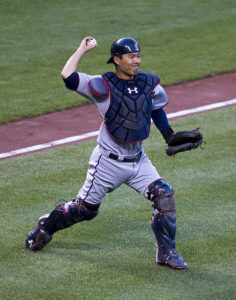
Baseball is one of those sports where size doesn’t matter. You don’t have to be 6 feet, 10 inches tall, or weigh 300 lbs. to stand out.
In an interview in Cut, Braves catcher Kurt Suzuki recalls playing with lots of Asian American kids while growing up in Maui, Hawaii. As he went up the athletic ladder — high school, college, minor leagues — there were fewer and fewer players that looked like him.
It’s surprising that more Asian Americans aren’t playing in the major leagues. We have the same access to the Little League, high school teams as anybody else. I’d venture to guess that parental pressure to excel in academics could partially be the blame for the lack of AAPI athletes in Major League Baseball.
It’s not like we haven’t had role models. The first Asian American player in MLB was Bobby Balcena, who was Filipino American and debuted with the Reds in 1956. Since then there have been a few players who are of AAPI descent, including the likes of Dave Roberts, Travis Ishikawa, Jeremy Guthrie, Addison Russell, Shane Victorino and Tim Lincecum.
LATEST STORIES
The popularity of the sport in Asia has helped produce players from that region who have had success in MLB. Ichiro Suzuki (no relation) of the Mariners is a sure Hall of Famer when he chooses to retire. Shohei Ohtani is the latest players from Japan to make waves as that rare two-way player, pitching and hitting for the L.A. Angels.
Suzuki has made more than $30 million in his career as a catcher for the Oakland Athletics, Washington Nationals and Minnesota Twins. He was an American League All-Star in 2014 for Minnesota, where he finished a three-year run at the end of the 2016 season and became a free agent. He eventually signed on with the Braves and got a one-year extension for 2018.
There are few Asian American players who choose to follow their passion and advance to the majors. It sometimes seems there are more players from Asia than Asian Americans playing in the big leagues.
So the rare connections with other Asian American players, when they come, are prized. “When I was with Don Wakamatsu,” Suzuki told Cut, “he was my bench coach in Oakland — it was pretty cool to have both of us. We’d talk all the time, we’d go out to breakfast … we’d talk about the culture and things like that.”
Wakamatsu, who is now the bench coach for the Rangers and who played 18 games with the White Sox in 1991, was also MLB’s first Asian American manager, managing the Seattle Mariners from 2009-10.
Near the end of his baseball career, Suzuki, finds himself in an uncomfortable position.
“I don’t like to say it, but you kind of think of yourself as a role model a little bit,” Suzuki said. “You want to be a good role model to these kids and show these kids how to do things right. That’s kind of what we’re doing with the clinic here.”
“It’s definitely cool when you have an idea (that) there’s possibly some kids looking up to you to probably follow in your footsteps,” Suzuki told Cut. “It’s not a big percentage of [Asian American] players in Major League Baseball, but if you’re talented, you know, you can do it. And if you keep your mind to it and keep your head straight, anything can happen.”
AsAmNews has Asian America in its heart. We’re an all-volunteer effort of dedicated staff and interns. Check out our Twitter feed and Facebook page for more content. Please consider interning, joining our staff or submitting a story.









RE: One of the few Asian American players in Major League Baseball Offers Advice: author left out Ron Darling